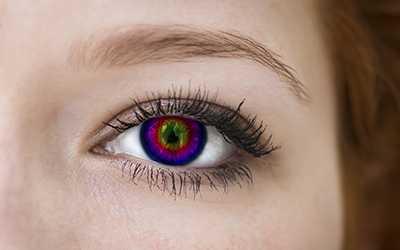Decorative Contact Lenses

If you have ever wished that your eyes were a different color—or that you could give them a different “look”—you might understand why decorative contact lenses appeal to some people. There are many names for contact lenses that are used to change the appearance of the eyes, including cosmetic, theatrical, Halloween, circle, decorative, costume, or colored contact lenses. These types of lenses may also be used to improve vision. Whether they improve vision or not, all contact lenses require a prescription 1 and proper care to lower the risk of eye infections and other complications.
All contact lenses require a prescription
All contact lenses are medical devices that are regulated by the U.S. government 2. By law, decorative contact lenses, whether they correct vision or not, require a prescription and proper fitting from an eye doctor 3. Any type of contact lens that can be purchased without a prescription is being sold illegally—and can pose serious risks to sight and eye health 2. Do not purchase decorative contact lenses from costume shops, beauty salons, drug stores, flea markets, or anywhere that doesn’t require a prescription 2. You can buy contact lenses from eye doctors’ offices, online, or by mail order but only with a valid prescription 2. You should continue care as directed by your eye doctor with any type of contact lens purchased.
Colored or decorative contact lenses are not risk-free
People who wear any type of contact lenses need to practice proper wear and care steps to keep their eyes healthy 4. No type of contact lens is risk-free. Improper care of contact lenses increases the chances of infections and other complications 5. When decorative contact lenses are sold without a prescription, proper fitting, and education about wear and care from an eye doctor, there appears to be a greater risk of permanent eye damage—even blindness 4.
Follow tips for healthy wear and care
NEVER share your contact lenses with someone else! Each pair is prescribed and fitted specifically for your eyes.
For all types of contact lenses, not wearing and caring for them properly raises the chances of serious eye infections 6, 7.
- Never share contact lenses with others 2.
- Rub and rinse your contact lenses with contact lens disinfecting solution—never water or saliva—to clean them each time you remove them. Even if worn occasionally, contact lenses must be disinfected and stored in new solution at least every 7 days 8, 9.
- Never store your contact lenses in water 10, 11.
- Replace your contact lenses as often as recommended by your eye doctor 12, 13.
- Replace your contact lens case at least once every three months 14-16.
- Don’t “top off” solution. Use only fresh contact lens disinfecting solution in your case—never mix fresh solution with old or used solution 17, 18.
All contact lens wearers should follow these healthy contact lens use tips.
References
- Steinemann TL, Pinninti U, Szczotka LB, Eiferman RA, Price FW Jr. Ocular complications associated with the use of cosmetic contact lenses from unlicensed vendors. Eye Contact Lens. 2003;29(4):196-200.
- FDA. Decorative contact lenses. 2014.
- Young G, Young AG, Lakkis C. Review of complications associated with contact lenses from unregulated sources of supply. Eye Contact Lens. 2013.
- Steinemann TL, Fletcher M, Bonny AE, Harvey RA, Hamlin D, Zloty P, Besson M, Walter K, Gagnon M. Over-the-counter decorative contact lenses: Cosmetic or medical devices? A case series. Eye Contact Lens. 2005;31(5):194-200.
- Chalmers RL, Keay L, Long B, Bergenske P, Giles T, Bullimore MA. Risk factors for contact lens complications in US clinical practices. Optom Vis Sci. 2010;87(10):725-35.
- Keay L, Stapleton F, Schein O. Epidemiology of contact lens-related inflammation and microbial keratitis: a 20-year perspective. Eye Contact Lens. 2007;33(6 Pt 2):346-53, discussion 362-3.
- Dart JK, Stapleton F, Minassian D. Contact lenses and other risk factors in microbial keratitis. Lancet. 1991;338(8768):650-3.
- Yung MS, Boost M, Cho P, Yap M. Microbial contamination of contact lenses and lens care accessories of soft contact lens wearers (university students) in Hong Kong. Ophthalmic Physiol Opt. 2007;27(1):11-21.
- Sweeney D, Holden B, Evans K, Ng V, Cho P. Best practice contact lens care: a review of the Asia Pacific Contact Lens Care Summit. Clin Exp Optom, 2009;92(2):78-89.
- Joslin CE, Tu EY, Shoff ME, Booton GC, Fuerst PA, McMahon TT, Anderson RJ, Dworkin MS, Sugar J, Davis FG, Stayner LT. The association of contact lens solution use and Acanthamoeba keratitis. Am J Ophthalmol, 2007;144(2):169-180.
- Hammersmith KM. Diagnosis and management of Acanthamoeba keratitis. Curr Opin Ophthalmol, 2006;17(4):327-31.
- Dumbleton KA, Woods CA, Jones LW, Fonn D. The relationship between compliance with lens replacement and contact lens-related problems in silicone hydrogel wearers. Cont Lens Anterior Eye, 2011;34(5):216-22.
- Dumbleton K, Woods C, Jones L, Richter D, Fonn D. Comfort and vision with silicone hydrogel lenses: effect of compliance. Optom Vis Sci, 2010;87(6):421-5.
- FDA. Contact lens risks. 2014.
- DePaolis M, Cho P, Cunningham D, Morgan PB, Quinn TG, Saks AP, Shovlin JP. What do we do now? Implications for the clinical practice. Cont Lens Anterior Eye. 2013;36 Suppl 1:S28-33.
- American Optometric Association. Contact lenses. 2013.
- Chang DC, Grant GB, O'Donnell K, Wannemuehler KA, Noble-Wang J, Rao CY, Jacobson LM, Crowell CS, Sneed RS, Lewis FM, Schaffzin JK, Kainer MA, Genese CA, Alfonso EC, Jones DB, Srinivasan A, Fridkin SK, Park BJ; Fusarium Keratitis Investigation Team. Multistate outbreak of Fusarium keratitis associated with use of a contact lens solution. JAMA. 2006;296(8):953-63.
- Levy B, Heiler D, Norton S. Report on testing from an investigation of Fusarium keratitis in contact lens wearers. Eye Contact Lens. 2006;32(6):256-61.
- Page last reviewed: October 24, 2014
- Page last updated: October 24, 2014
- Content source:


 ShareCompartir
ShareCompartir